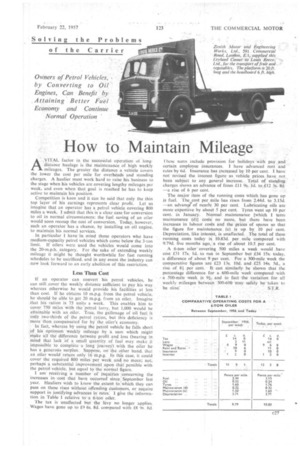How to Maintain Mileage
Page 55

If you've noticed an error in this article please click here to report it so we can fix it.
AVITAL factor in the successful operation of longdistance haulage is the maintenance of high weekly mileages. The greater the distance a vehicle covers the lower the cost per mile for overheads and standing charges. A haulier must work hard to raise his business to the stage when his vehicles are covering lengthy mileages per week, and even when that goal is reached he has to keep active to maintain his position.
Competition is keen and it can be said that only the thin top layer of his earnings represents clear profit. Let us imagine that an operator has a petrol vehicle covering 800 miles a week. I admit that this is a clear case for conversion to oil in normal circumstances: the fuel saving of an oiler would soon recoup the cost of conversion. Today, however, such an operator has a chance, by installing an oil engine. to maintain his normal services.
In particular I have in mind those operators who have medium-capacity petrol vehicles which come below the 3-ton limit. If oilers were used the vehicles would come into the 20-m.p.h. category. For the sake of extending weekly mileage it might be thought worthwhile for fast running schedules to be sacrificed, and in any event the industry can now look forward to an early abolition of this restriction.
Less Than Cost
If an operator can convert his petrol vehicles, he can still cover the weekly distance sufficient to pay his way whereas otherwise he would provide his facilities at less than cost. If he obtains 10 m.p.g. from the petrol vehicle. he should be able to get 20 m.p.g. from an oiler. Imagine that his ration is 75 units a week. This enables him to cover 750 miles with the petrol lorry, but 1,000 would be attainable with an oiler. True, the gallonage of oil fuel is only two-thirds of the petrol ration, but this deficiency is more than compensated for bY the oiler's economy.
In fact, Whereas by using the petrol vehicle he falls short of his optimum weekly mileage by a sum which might Make all the differenee between profit and loss (bearing in mind that lack of a small quantity of fuel may make it inipossible to complete .a.long journey) with the oiler he has a generous surPlus. Suppose, on the other hand. that an oiler would'return only 16 m.p.g. In this case, it could cover the required 800 miles :per week an no more; not, perhaps a substantial improvement :upon .tht possible with the petroVvehicle. but equal to-the normal figure.
I am receiving a number of inquiries :concerning the increases in -cost that have occurred since, September last year. Hauliers wish to know the extent to which they can pass on these rises Without offending customers, or require support in justifying advances in rates. I give the information in Table I relative to-a 6-ton oiler.
The tax is unaffected but the levy no longer applies. Wages have gone up to V 6s. 8d. compared with .E8 9s. 8d. These sums include provision for holidays with pay and certain employee insurances. I have advanced rent and rates by 6d. Insurance has increased by 10 per cent. I have not revised the interest figureas vehicle prices have not been subject to any general increase. Total of statkding charges shows an advance of from £11 9s. Id. to £12 3s. 8d —a rise of 6 per cent.
The major item of the running costs which has gone up is fuel. The cost per mile has risen from 2.44d. to 3.15d. —an advanclof nearly 30 per cent Lubricating oils are more expensive by about 5 per cent. Tyres went up 10 per cent. in January. Normal maintenance [which I teim maintenance (d)] costs no more, but there have been increases in labour costs and the prices of spares so that the figure for maintenance (e) is up by 10 per cent. Depreciation, like interest, is unaffected. The total of these running costs today is 10.83d. per. mile compared with 9.79d. five months ago, a rise of about 10.5 per cent.
.A 6-ton oiler covering 500 miles a week would have cost £31 17s: Id. to run in September but £34 1.55. today, a difference of about 9 per cent. For a 300-mile week the comparative figures are £23 13s. 10d. and £25 14s. 5d., a rise of 81 per cent. It earl similarly be shown that the percentage difference for a 600-mite week compared with a .500-mile week is 9i-, and in fact the variation for. all weekly mileages between 300-600 may safely be taken to
be nine: S.T.R.
























































































